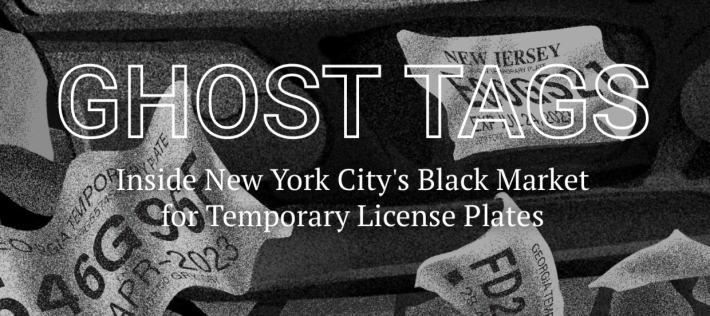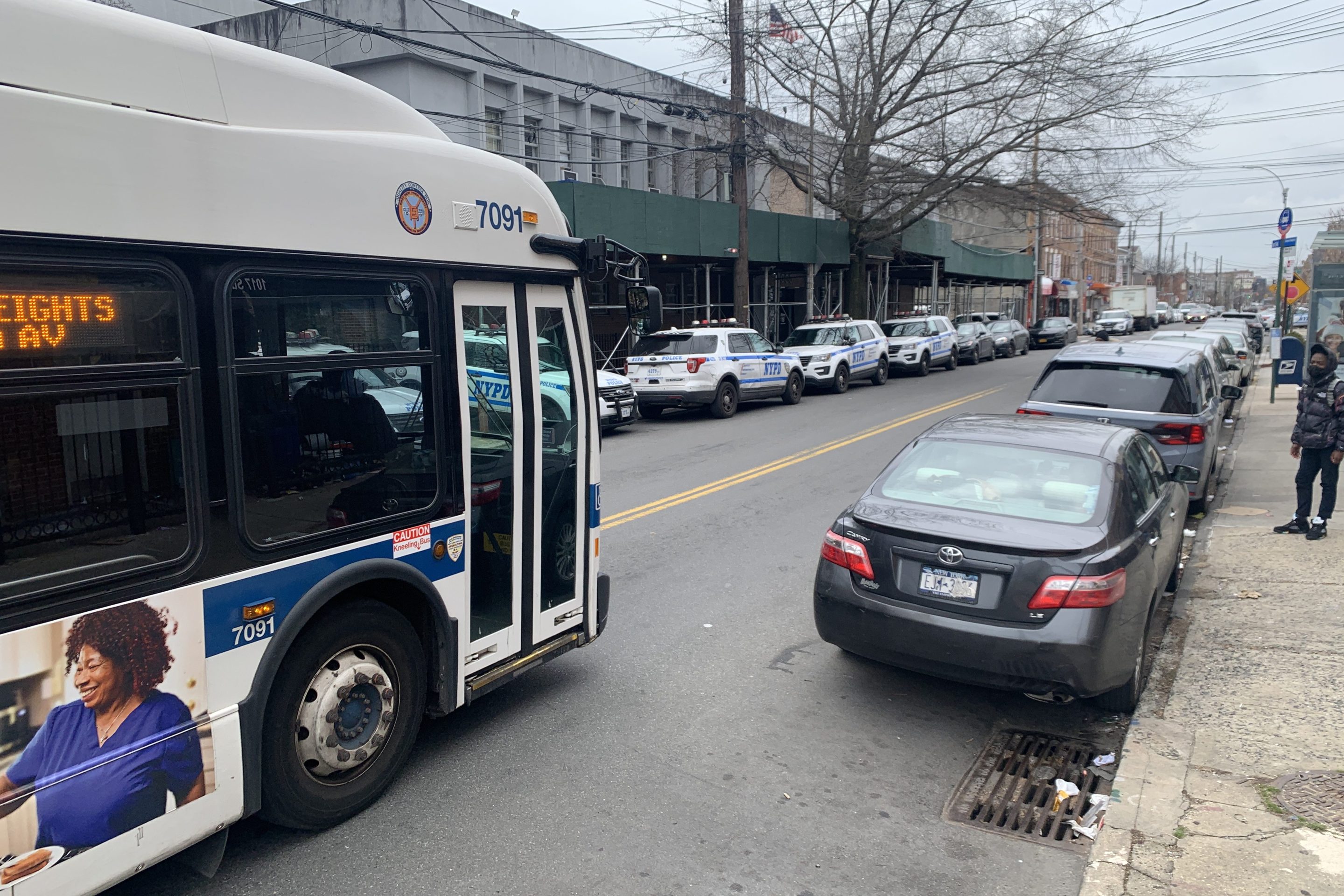Message received — and then blown off.
The NYPD is arresting far fewer drivers this year for driving around with fake or defaced plates compared to last year, despite a promise to crack down ghost cars, the agency revealed at a Council hearing on Monday.
At the City Council hearing, which follows Streetsblog's coverage of the "ghost car" and covered plate crisis, NYPD Transportation Bureau Executive Officer Michael Pilecki revealed that arrest numbers are trending in the wrong direction:
To date this year, Pilecki said, cops have arrested 1,777 drivers for "forged or altered plates" — which, if that rate holds, would be 11 percent lower than the 4,199 drivers arrested for the same crime in all of 2022.
And the agency's larger effort to combat covered or obstructed plates is stagnant compared to last year, Pilecki added. To date this year, cops have issued 123,741 summonses to vehicles with covered or obstructed plates — which, if that rate holds, would represent just a 0.6-percent increase from the 258,000 summonses that were issued all of 2022.
According to Pilecki's testimony, 2022 seems to have been a high water mark for NYPD enforcement of the ghost tag problem; the 4,199 arrests in 2022 were up 17 percent from the previous year and up 257 percent from the last pre-pandemic year, 2019.

But that rise has not continued. And Pilecki presented the statistics in a manner that made it difficult for Council members to determine, on the fly, whether the NYPD had stepped up its efforts against the scourge of ghost cars or not.
For instance, at one point, he said that the NYPD had towed 7,200 cars for "paper plates" in 2022, but had towed only 1,100 for “covered or obstructed” plates so far this year — seemingly different categories. He never ended up saying how many cars had been towed this year for paper plates — and no one on the Public Safety and Transportation committees asked him.
He also declined to take questions from Streetsblog after the joint committee hearing. (We reached out to NYPD and will update this story if we hear back.)
"They're barely putting a dent in the problem," said Eric McClure, executive director of Streetsblog, testifying in support of two bills by Council Member Oswald Feliz (D-Bronx), one that would at least substantially raise the fines for using fake plates or defacing a place, and another that would do the same for selling fake plates. "If rates are down or flat from 2022 to 2023, it would be a big disappointment. It certainly feels like the problem is getting worse, and the more offenders go unpunished, the more likely it is that use of fake, obscured, and defaced plates will proliferate."
A decrease in arrests could be explained if the problem of covered and defaced plates is decreasing. And it may be, at least among police officers, thanks to an effort to crack down on cops as they drive to the shooting range in the Bronx, as the New York Post recently reported.
Gov. Hochul also announced increased fines for covered plates, raising the summons to $250 from $65, a more substantial disincentive.
One area where the NYPD is apparently stepping up enforcement is on moving violations issued by cops for covered plates, Pilecki said.
This year, for example, NYPD officers have issued 6,321 moving violation summonses to drivers who cover or obstruct their plates, up 151 percent from 2,513 during the same period last year, he said.
At a city council hearing on ghost tags right now, @NYPDnews just said the database that their officers use to determine whether a temporary license plate is real only contains info on temp tags from 10 states. Even temp tags from New Jersey aren't in that database.
— Jesse Coburn (@Jesse_Coburn) June 26, 2023
Under questioning, Pilecki alluded to a problem with cracking down on fraudulently issued temporary tags: Cops can't always tell the difference between a legitimately issued temp tag — i.e. one obtained by the buyer or leasee of a specific car from that car's registered dealer — vs. a fake temp tag (the kind issued by either real or fake dealers that has no connection to any car, as Streetsblog reported in its "Temp Tag Tuesday" buying stunt).
He explained the process step by step: When officers pull over a car, they check the registration and license through something called the New York State Police Information Network — but 40 states, including New Jersey, do not provide NYSPIN with their temp tag registration information.
That's a problem — but it's not the same problem that Pilecki acknowledged, because vast numbers of temp tags are being issued by legitimate dealers, yet are still fraudulent because the dealer never sold a car to the temp tag buyer. Those plates would still be in a state's online registry, even though they're still issued fraudulently.
Indeed, the main problem with cracking down on ghost cars — namely, that many legitimate, registered dealers illegally sell real temp tags — hardly came up at the hearing.
Feliz's bills have widespread support — indeed, the NYPD testified in support of them — and are expected to easily pass, though it is unclear how the city will crack down on the sellers of fraudulent temp tags. The city is already going after vendors, both online and in brick-and-mortar locations who sell plate covers.
Also left unsaid at the hearing was why the Department of Transportation's automated enforcement cameras can't bill drivers with even legitimate temp tags, let alone fake ones, meaning the agency never holds those drivers accountable for speeding near schools or running red lights.
Streetsblog asked Joshua Benson, DOT Deputy Commissioner for Traffic Operations, why his agency can't bill drivers with paper tags after the hearing, but he declined to answer, directing questions to the DOT press office.
After this story published, a DOT spokeswoman said the cameras can "sometimes read temporary tags, but it’s more difficult to connect temporary tags back to their owners. We’re exploring automated solutions to trace a high volume of temporary tags back to vehicle owners."
DOT was unable to bill 1.2 million drivers caught potentially speeding or running red lights last year because those drivers had temp tags or no plates at all, according to DOT data. That's more than 4 percent of all drivers caught by DOT's automated cameras.
The Metropolitan Transportation Authority and the Port Authority, other agencies that rely on license plate cameras to bill motorists, have no problem sending toll bills to drivers with legitimate temp tags, spokespeople told Streetsblog.
The DOT did not respond to a question about why it can't ticket temp tag drivers but the other agencies can.
One of the main stars of the hearing was Streetsblog itself.
Not only did Pilecki did confirm virtually everything that had been contained in Jesse Coburn's exhaustive three-part series on fraudulently issued temp tags, but also alluded to this reporter's efforts to personally uncover or repaint illegally unreadable plates.
And activists also praised Streetsblog. Eric McClure of StreetsPAC praised Coburn's "wide-ranging investigation" as he testified in support of Feliz's bills. The need for the legislation was "illustrated by Streetsblog, both Jesse Coburn's series and, of course, editor Gersh Kuntzman's 'criminal mischief' series," Danny Pearlstein of Riders Alliance added.
Pearlstein also pointedly confronted Feliz about his support for cracking down on ghost cars, yet opposing bus improvements along Fordham Road in his district.
"This is about equity, right? Drivers using those plates are abusing the privilege to operate a car in public space and they're yet another obstacle to the fast and reliable service that bus riders so sorely need," he said. "Busways, of course, are the strongest remedy that the city has in its toolkit ... but nowhere is a bus way more clearly indicated than on Fordham Road in the Bronx where 85,000 riders every single day use what is in essence the Cross Bronx Expressway of bus routes."
Neither Council Member Selvena Brooks-Powers, who chairs the Transportation Committee, nor her Public Safety Committee counterpart Kamillah Hanks responded to a request for comment.
— with Jesse Coburn






